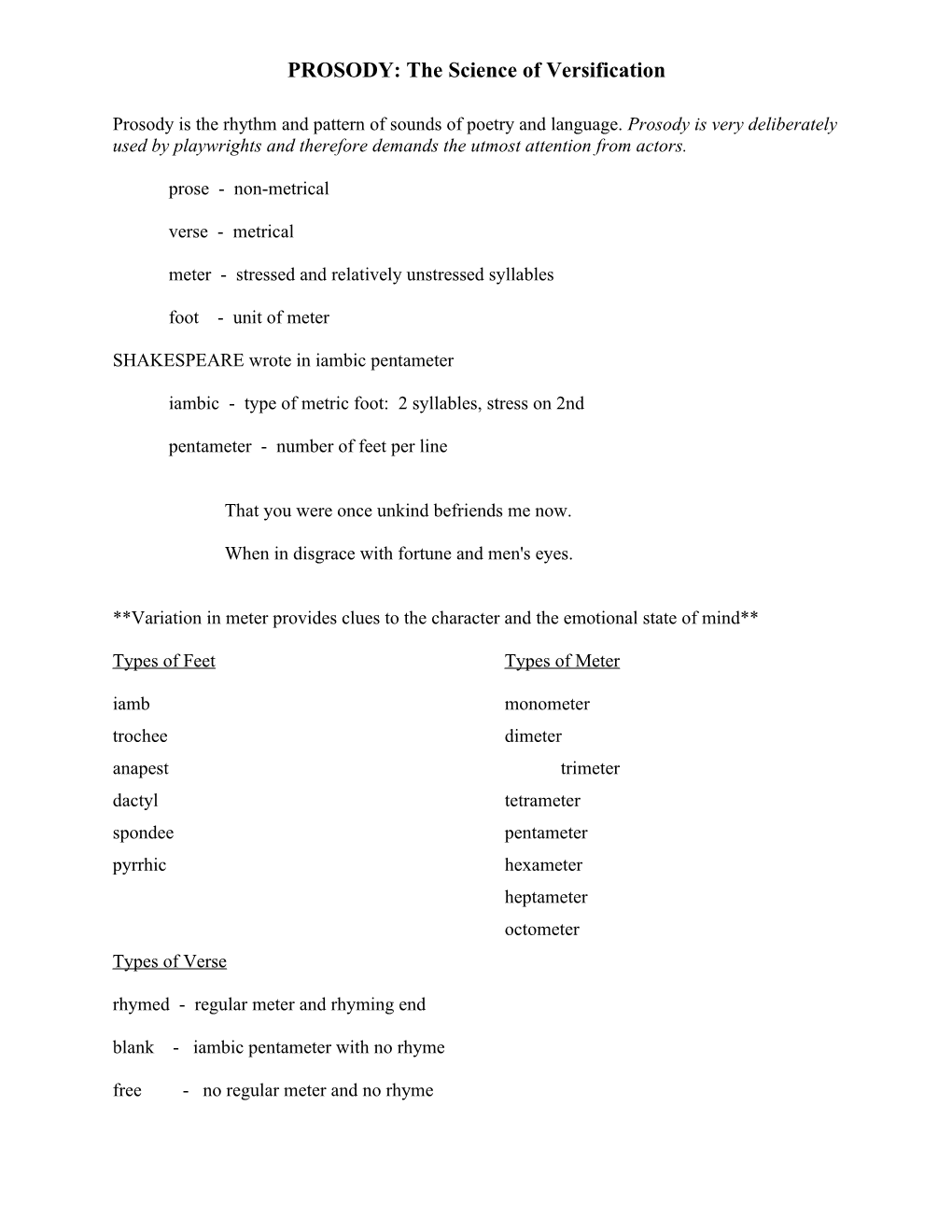PROSODY: The Science of Versification
Prosody is the rhythm and pattern of sounds of poetry and language. Prosody is very deliberately used by playwrights and therefore demands the utmost attention from actors.
prose - non-metrical
verse - metrical
meter - stressed and relatively unstressed syllables
foot - unit of meter
SHAKESPEARE wrote in iambic pentameter
iambic - type of metric foot: 2 syllables, stress on 2nd
pentameter - number of feet per line
That you were once unkind befriends me now.
When in disgrace with fortune and men's eyes.
**Variation in meter provides clues to the character and the emotional state of mind**
Types of Feet Types of Meter
iamb monometer
trochee dimeter
anapest trimeter
dactyl tetrameter
spondee pentameter
pyrrhic hexameter
heptameter
octometer
Types of Verse
rhymed - regular meter and rhyming end
blank - iambic pentameter with no rhyme
free - no regular meter and no rhyme
slant rhyme (near rhyme, half rhyme) - an imperfect rhyme
Devices of Sound
rhyme - ending or internal
alliteration - repetition of initial sound
onomatopoeia - word representing natural sounds
assonance - similarity of vowel sounds ("lake fate")
consonance - similarity of consonant sounds ("seems asleep")
refrain - repetition of lines
repetition - reiterating a word or phrase
antithesis (contrast) - balances words or ideas in sync or opposition
Other Devices
enjambment - sense and/or rhythm of one line runs into the next
masculine endings - line's last syllable stressed
feminine endings - line's last syllable unstressed
caesura - rhythmic pauses (breath) derived from the context
elision - syllable combined with another
rhymed couplet - rhymes last words in last two lines
**iambs and enjambment create the illusion of natural speech**
Wretched in this alone that thou mayest take
All this away and me most wretched make.
Analyzing a text for prosody is called scansion. It includes scanning for meter, devices of sound and types of verse. Scansion is the starting place, the jumping off point. It provides a way in to the text and is the actor's treasure map with clues towards the emotion, action and characters of the play.
Scansion Notations
indicates caesura
indicates transition or shift
indicates enjambed line
indicates elision
indicates irregular line/extra beat
indicates irregular line/missing beat
indicates division of feet
Speaker: If virtue no delighted beauty lack,
Your son-in-law is far more fair than black.
Speaker: Look to her, Moor, if thou hast eyes to see.
She has deceived her father, and may thee.
Speaker: This is the night
That either makes me or fordoes me quite.
Identify the following in the poem below: type of feet, type of meter, rhyme pattern, rhymed couplet, slant rhyme, enjambment, caesuras, the elision, antithesis, alliteration, assonance, consonance, repetition, the transition/shift.
SONNET 23 by Shakespeare
As an unperfect actor on the stage,
Who with his fear is put besides his part,
Or some fierce thing replete with too much rage,
Whose strength's abundance weakens his own heart;
So I, for fear of trust, forget to say
The perfect ceremony of love's rite,
And in mine own love's strength seem to decay,
O'ercharg'd with burden of mine own love's might.
O let my books be then the eloquence
And dumb presagers of my speaking breast,
Who plead for love and look for recompense
More than that tongue that more hath more express'd.
O, learn to read what silent love hath writ:
To hear with eyes belongs to love's fine wit.
*Optional challenge: identify any similes, metaphors and apostrophes (addressing an absent person or thing).
